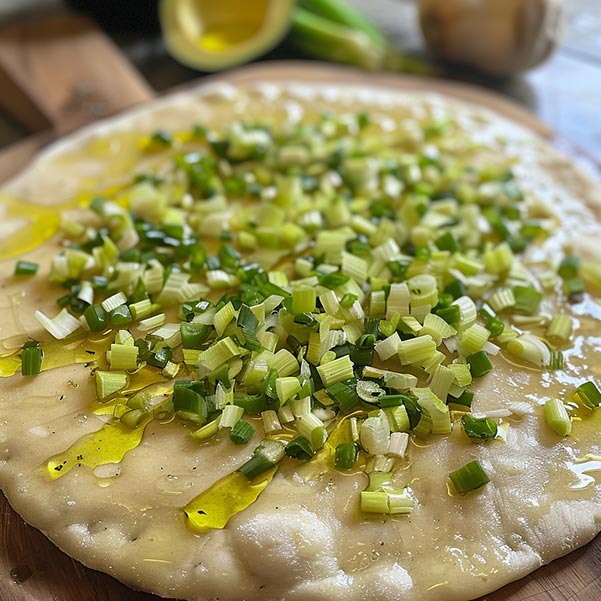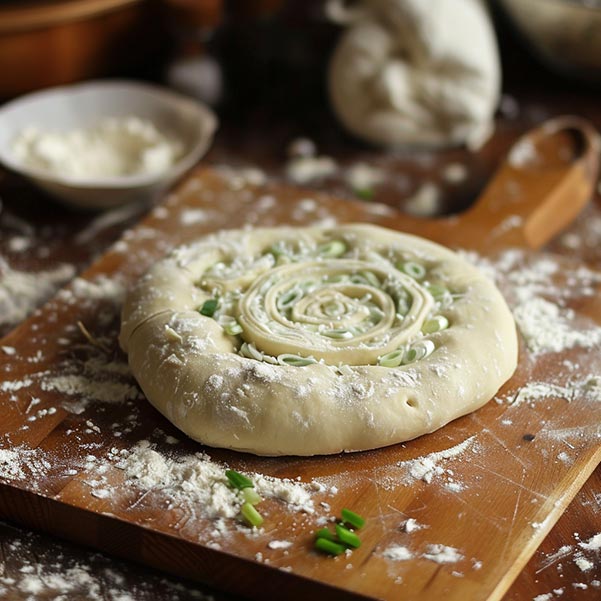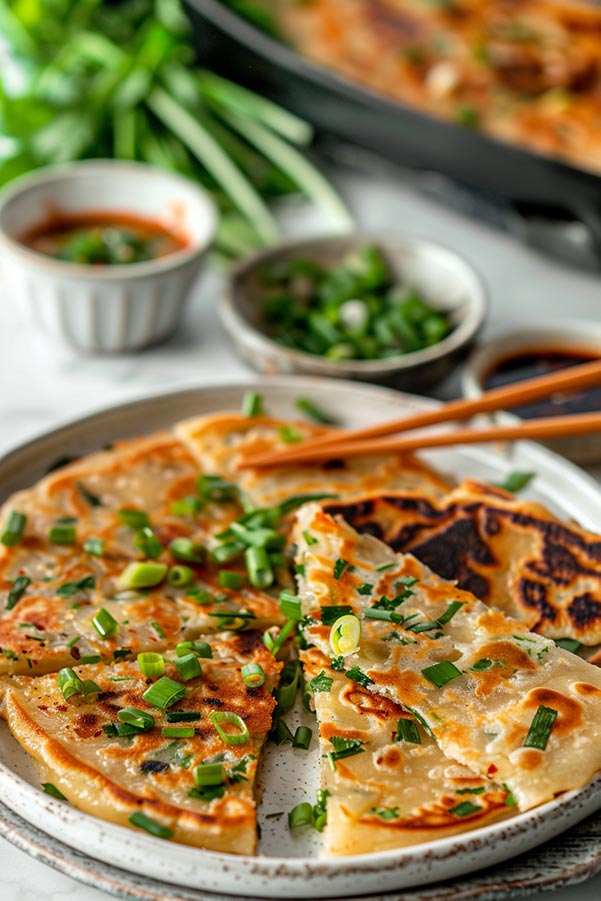The scent of freshly cooked scallion pancakes permeating the air is undeniably enticing and irresistible. These delectable treats from the heart of Chinese cuisine have gained popularity worldwide for their crispy exterior, tender layers, and tantalizing combination of savory flavors. Whether you're a seasoned chef or an enthusiastic home cook, learning to make scallion pancakes is a delightful culinary adventure that impresses your family and friends.
In Chinese cuisine, scallion pancakes are referred to as cong you bing in Mandarin and are cherished as a beloved and timeless staple. Despite their name, these pancakes are not your typical breakfast variety. Instead, they are a versatile dish enjoyed throughout the day, either as a side dish, a light snack, or even as a main course when paired with dipping sauces and other complementary ingredients.
While making homemade scallion pancakes may sound like a challenging task, with a little patience and practice, you'll soon find yourself easily creating these golden discs of deliciousness. In this blog, I will share my favorite scallion pancake recipe along with some tricks and tips.
Flakey Chinese Scallion Pancakes Recipe
Prep Time
20 minutes
Cook Time
10 minutes
Rest Time
30 minutes
Total Time
1 hour
Ingredients
Directions
Prepare the dough:
1. Combine the all-purpose flour and salt in a spacious mixing bowl.
2. Add warm water to the flour mixture while stirring with a fork or chopsticks. Continue mixing until a shaggy dough forms.
3. Work the dough on a surface dusted with flour until it achieves a smooth and elastic consistency, usually taking around 5 minutes.
4. Form the dough into a ball, then cover it with a moist cloth and let it rest for 30 minutes.
Roll out the dough:
1. Once the dough has finished resting, proceed to divide it into four equal portions. Roll one portion into a thin, rectangular shape on a floured surface. Begin rolling the dough from the center, gradually working outward while rotating it as necessary. Apply gentle pressure at first, gradually increasing it as you roll, aiming to achieve a thickness of approximately 1/8 inch.

2. Evenly coat the surface of the rolled dough with a thin layer of sesame oil using a brush. Sprinkle a generous amount of chopped scallions over the oiled surface, gently pressing them into the dough.

3. Begin tightly rolling the dough into a log, starting from one end. Take the rolled dough and twist it into a spiral, tucking the end underneath to secure it.
4. Flatten the spiral gently with your hand, then roll it out again into a thin pancake shape. The scallions should be visible through the dough.
Cook the scallion pancakes
1. Warm a skillet or frying pan over medium heat and add a tablespoon of avocado oil.
2. Gently transfer the rolled-out pancake to the pan and cook each side for approximately 2-3 minutes until it turns golden brown and crispy. Repeat this process for the remaining dough portions and scallions, adding additional oil as necessary.
3. After cooking, transfer the pancakes to a plate lined with paper towels to soak up any excess oil. Proceed to cut the scallion pancakes into wedges or serve them whole. Serve them warm with soy sauce or your favorite dipping sauce.
Tips & Notes
Heat and oil: Preheat your skillet or frying pan over medium heat before adding the pancake. This ensures even cooking and prevents sticking. Add enough oil to coat the bottom of the pan generously, as this helps achieve the desired crispy texture.
Thin and even pancakes: Roll out the dough to achieve maximum thinness without causing any tearing. Thinner pancakes result in a crispier texture. Additionally, try to roll the dough into an even shape to ensure consistent cooking.
Nutritional Facts
Nutrition Facts
Servings: 4
Calories
290
% Daily Value*
Total Fat 7.4g
10%
Saturated Fat 1.1g
5%
Cholesterol 0mg
0%
Sodium 586mg
25%
Total Carbohydrate 48.2g
18%
Dietary Fiber 1.9g
7%
Total Sugars 0.3g
Protein 6.6g
Vitamin D 0mcg
0%
Calcium 17mg
1%
Iron 3mg
17%
Potassium 88mg
2%
*The % Daily Value (DV) tells you how much a nutrient in a food serving contributes to a daily diet. 2,000 calorie a day is used for general nutrition advice.
Scallion distribution: When adding the chopped scallions to the pancake, distribute them evenly across the surface. This ensures a balanced flavor in every bite. Press the scallions gently into the dough to help them adhere and prevent them from falling out while cooking.
Patience and flipping technique: When flipping the pancakes, do it confidently but gently. Utilize one or two spatulas to support the pancake, and flip it over with caution. Be patient and avoid flipping too early, as this can cause the pancake to break apart.
Drain excess oil: After cooking the scallion pancakes, transfer them to a plate or wire rack lined with paper towels to allow the excess oil to drain. This step helps maintain their crispy texture and prevents them from becoming soggy.
What Is Scallion Pancake
Scallion pancake, also known as cong you bing (green onion pancake) in Mandarin, is a traditional Chinese savory pancake made with a simple dough and filled with chopped scallions (green onions). Despite their name, scallion pancakes are not sweet breakfast pancakes but a delicious and versatile dish enjoyed throughout the day.
Scallion pancakes are commonly served as a side dish, appetizer, or snack in Chinese cuisine. They can be enjoyed on their own or paired with dipping sauces like soy sauce, vinegar, or chili sauce for added flavor. Some scallion pancake variations may incorporate ingredients like sesame oil, garlic, or spices to add extra flavor and complexity.
The appeal of scallion pancakes lies in their crispy texture, the savory flavors of the scallions, and their versatility. These scallion pancakes can be savored in your home or ordered at Chinese restaurants worldwide. Whether as a delightful treat or a satisfying accompaniment to a meal, scallion pancakes are beloved for their simple yet irresistible combination of ingredients.
What Ingredients You Need To Make Scallion Pancakes
All-Purpose Flour
All-purpose flour, a versatile essential found in most pantries, is widely used for baking and cooking. It is crafted from a mixture of hard and soft wheat varieties, producing balanced protein content. The protein, known as gluten, plays a crucial role in providing structure and elasticity to the dough. All-purpose flour in scallion pancakes creates a pliable and chewy dough that can be rolled out easily.
Warm Water
Warm water is employed to hydrate the flour and form the dough. The water temperature is crucial as it aids in activating the gluten present in the flour. By using warm water, gluten development is promoted, resulting in a dough that is more elastic and manageable. It also helps to dissolve the salt and aids in the overall hydration of the dough.
Salt
Salt plays a vital role as an essential ingredient in intensifying the flavor of scallion pancakes. It adds a savory and balanced taste to the dough, bringing out the natural flavors of the other ingredients. Additionally, salt plays a role in gluten development by strengthening the gluten structure, resulting in better texture and chewiness in the pancakes.
Avocado Oil
A generous amount of oil is used for frying the pancakes. This oil creates the desired crispy and golden exterior that adds a delightful texture to the pancakes. Some scallion pancake recipes recommend 1/2 cup of oil to try, which seems like a lot. You want a thin layer of oil and add a little at a time as you see fit because you don't want your scallion pancake to come out greasy.
Traditional Chinese scallion pancakes are fried in vegetable oil or canola oil. However, avocado oil is often considered a healthier option than conventional vegetable oil. Furthermore, avocado oil is an excellent option for frying scallion pancakes due to its high smoking point, which means it can withstand the heat without breaking down.
Sesame Oil
Making scallion pancakes with sesame oil is a wonderful way to infuse them with a rich, nutty flavor. You can add a delightful aromatic twist to this classic Chinese dish by incorporating sesame oil into the dough.
If you are unsure about the sesame oil for its strong flavor or how it tastes, you can make an oil mixture. You can tone down the rich, nutty taste by mixing avocado and sesame oil. If you don't like the taste of sesame oil, you can swap it with avocado oil.
Scallions (Green Onions)
Scallions, alternatively referred to as green onions or spring onions, are vital for imparting a distinct flavor and aroma to scallion pancakes. These youthful onions feature long green stalks and small white bulbs, contributing a refreshing and mild onion taste that is less overpowering than fully matured onions. When cooked, scallions become tender and release their aromatic fragrance, infusing the pancakes with their unique taste. The vibrant green color of the scallions also adds visual appeal to the pancakes.
Soy Sauce Or Dipping Sauce
While not directly used in the scallion pancake preparation, soy sauce or dipping sauce is often served alongside scallion pancakes as a condiment. Soy sauce, an essential ingredient in Asian cuisine, brings a savory and umami-rich flavor. Other dipping sauces, such as vinegar-based or chili-based sauces, can also be paired with scallion pancakes to provide additional tanginess or heat, depending on your preference. Dipping sauces elevate the taste of the pancakes and offer a delightful contrast to the crispy and savory nature of the dish.
How To Elevate Scallion Pancakes
Dipping Sauces
Pair your scallion pancakes with a variety of flavorful dipping sauces. Classic options include chili oil, soy sauce, and rice vinegar. You can also experiment with homemade or store-bought sauces, such as sweet chili, hoisin, or tangy peanut sauce.
Add Protein
To make scallion pancakes more substantial, you can incorporate protein-rich ingredients. Consider adding thinly sliced cooked chicken, beef, or shrimp to the pancake filling before rolling and cooking. This addition provides extra texture and flavor to the pancakes.
Herb Infusion
Enhance the taste of your scallion pancakes by adding fresh herbs to the dough or garnishing the cooked pancakes with them. Adding cilantro, basil, or mint can introduce a refreshing and aromatic dimension to the dish, enhancing its overall flavor profile. Simply chop the herbs and mix them into the dough or sprinkle them on top of the cooked pancakes for freshness.
Spices And Seasonings
Add spices and seasonings to the pancake dough to create unique flavor profiles. Consider incorporating ingredients like garlic powder, Chinese five-spice powder, ground black pepper, or even a touch of chili powder to add a kick of heat. These additions can enhance the overall taste and contribute to a more intricate and multifaceted flavor profile.
Fusion Fillings
Unleash your creativity and venture into fusion cuisine by experimenting with various fillings to impart an innovative twist to your scallion pancakes. Add ingredients like shredded cheese, kimchi, cooked bacon, or caramelized onions to the pancake filling. These additions introduce new flavors and textures, making your scallion pancakes a delightful fusion of cultures.
Make Scallion Pancake Wraps
Use scallion pancakes as a base to wrap other ingredients, similar to a wrap or a burrito. Fill them with grilled or stir-fried vegetables, tofu, or thinly sliced meat, and roll them up. This creates a delicious and portable meal with the scallion pancake as a flavorful casing.
Frequently Asked Questions (FAQ)
How To Store Leftover Pancakes
For short-term storage, it is recommended that the scallion pancakes be individually wrapped and then placed in an airtight container or sealable plastic bag. They can typically be kept in the refrigerator for up to 3 days.
If you wish to store scallion pancakes for an extended period, freezing is a viable option. Before freezing, ensure that the pancakes have completely cooled down. Then, stack the wrapped scallion pancakes with a layer of parchment paper or plastic wrap between each pancake to prevent sticking. Stack the scallion pancakes and put them in an airtight container or freezer bag. They can be frozen for a maximum of 2 months.
You can also freeze uncooked scallion pancakes. When you are ready to eat, you will need to defrost and heat them up properly. I don't recommend cooking frozen scallion pancakes directly in a hot pan. You should have the frozen scallion pancakes to thaw for at least 10 minutes before the cooking process.
Can I Use A Different Type Of Flour For Scallion Pancakes?
While all-purpose flour is commonly used, explore alternative options such as whole wheat flour or a blend of different flours for experimentation. However, remember that alternative flours may affect the texture and taste of the pancakes.
How Can I Achieve A Crispy Texture For My Scallion Pancakes?
To achieve a crispy texture, roll out the dough thinly. In addition, make sure that the oil in the pan is sufficiently hot before adding the pancake. Cooking on medium-high heat and using enough oil for frying will help create a crispy exterior.
How Do I Prevent Scallion Pancakes From Getting Too Oily?
It's important to use the right amount of oil for frying the pancakes. Ensure the oil is adequately hot before adding the pancake to prevent excessive absorption. Furthermore, place the cooked pancakes on a plate lined with paper towels to absorb any excess oil after frying.
Can I Freeze The Scallion Pancake Dough Instead Of Cooking It First?
It's not recommended to freeze the uncooked dough, as freezing may affect the texture and quality of the pancakes. It's best to cook the pancakes first and then freeze them later.
Can I Make Scallion Pancakes Without Scallions?
While scallions are a key ingredient in traditional scallion pancakes, you can experiment with other herbs or vegetables as substitutions. Chives, leeks, or thinly sliced onions can provide a similar flavor profile.
Are Scallion Pancakes Suitable For Vegetarians Or Vegans?
Scallion pancakes can be made vegetarian or vegan by using plant-based oils and ensuring that the ingredients, including the dipping sauce, are free of animal products. Check labels and choose vegan-friendly options when necessary.
Can I Use Cold Water To Make Scallion Pancakes?
Yes, it is possible to use cold water when making scallion pancakes. While warm water is often used in traditional recipes as it helps activate the gluten in the flour and makes the dough more pliable, cold water can also be used successfully.
When using cold water, remember that the dough may take slightly longer to come together and require additional kneading to achieve the desired texture. Cold water can also make the dough slightly firmer, which can affect the ease of rolling and shaping the pancakes. However, with patience and extra effort in kneading and rolling, you can still create delicious scallion pancakes using cold water. Cold water dough will also need to rest for longer, typically around 45 minutes to an hour, to allow the gluten to develop and the dough to relax before rolling it out.


